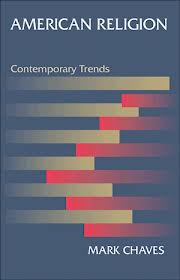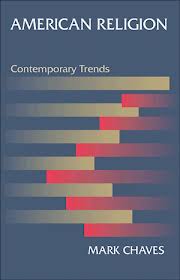 Mark Chaves, American Religion: Contemporary Trends (Princeton, NJ: Princeton University Press, 2011).
Mark Chaves, American Religion: Contemporary Trends (Princeton, NJ: Princeton University Press, 2011).
American Religion by Mark Chaves contains little good news for America’s religious leaders. Subtitled Contemporary Trends, the book examines continuity and discontinuity in American religious belief and practice over the last 40 years. While there are significant points of continuity in this time period—of belief in God and weekly attendance at religious services, for example—overall, the trend is toward discontinuity. “The religious trends I have documented point to a straightforward general conclusion,” Chaves writes: “no indicator of traditional religious belief or practice is going up” (emphasis in the original).
Chaves’ primary data sets are the General Social Survey (GSS) and the National Congregations Study (NCS), which he directed. Both surveys were conducted by the National Opinion Research Center of the University of Chicago. GSS has been conducted annually since 1972 and NCS in 1998 and 2006–7. Chaves is professor of sociology, religion, and divinity at Duke University, and his book is published by Princeton University Press. The book is brief (160 pages), but its data, author, and publisher make it an authoritative text whose conclusions religious leaders must wrestle with.
Here are some of those conclusions:
- America is increasingly a religious diverse nation, with a rising number of religiously unaffiliated persons—the so-called “nones” (chapter 2).
- Americans’ religious beliefs show remarkable continuity, except in the area of biblical inerrancy, which is declining (chapter 3).
- American religious involvement, measured by weekly attendance at a religious service is stable but softening (chapter 4).
- American congregations are shaped by “the same cultural, social, and economic pressures affecting American life and institutions more generally” and can be seen in six trends: “looser connections between congregations and denominations, more computer technology, more informal worship, older congregants, more high-income and college-educated congregants, and…more people concentrated in very large churches” (chapter 5).
- American religious leadership is a career choice for fewer and fewer people, and its ranks are older and less esteemed as pressionals than they used to be (chapter 6).
- Liberal Protestant denominations are declining but liberal religious ideas are increasing in influence. The decline in liberal Protestant denominations is not explained by transfer growth to conservative Protestant denominations. Rather, liberal Protestants are becoming “nones,” largely because of the increasing identification of religion and conservative politics (chapter 7).
- American religiosity is increasingly identified with social and political conservatism. On abortion, the most religiously active become increasingly conservative. But on gay marriage, the most religiously active liberalize at a pace slower than the religious population. Either way, the most religiously active Americans are more conservative than the less religiously active (chapter 8).
Chapter 9 summarizes the book’s findings this way: “If there is a trend, it is toward less religion.” Chaves’ is ambivalent about whether this trend is good or bad for America as a whole. On the one hand, he writes, “Increased tolerance of, even appreciation for, religions other than one’s own, described in chapter 2, is good news for our increasingly pluralistic society.” On the other hand, “Countering this positive trend…is the increasing attitudinal difference between the more religious and the less religious.” He goes on to write, “It would be ironic and unfortunate if Americans’ increasing appreciation for religions other than their own becomes overwhelmed by increasing hostility between the more and the less religious.”
There is another danger in the trend of religious non-affiliation. Chaves writes: “If half of all the social capital in America—meaning half of all the face-to-face associational activity, personal philanthropy, and volunteering—happens through religious institutions, the vitality of those institutions influences more than American religious life. Weaker religious institutions would mean a different kind of American civic life.”
As I noted at the outset, there is little good news for America’s religious leaders in Mark Chaves’ book. The trend is toward less religion. One could accentuate the positives and say that less religion means less nominal religion and more authentic religion, and perhaps there’s something to that. But in accentuating the positive, we shouldn’t overlook the very considerable negatives, mainly, less religion and more political antagonism to religion.
Of course, the New Testament church faced even greater odds and nonetheless grew in size and influence. But they were converting pagans to the faith of Jesus Christ. Can we experience a similar revival in a post-Christian society? In my opinion, that’s the fundamental question the American church needs to answer. And if yes, how? That’s the fundamental challenge facing American religious leaders today.
P.S. If you found this review helpful, please vote “Yes” on my Amazon.com review page.


One thought on ““No Indicator of Traditional Religious Belief or Practice Is Going Up”: A Review of “American Religion” by Mark Chaves”